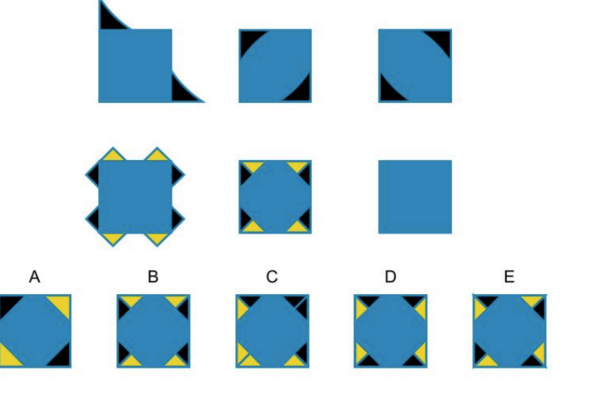The NNAT 5th-6th Grade Level E challenges students with complex nonverbal reasoning tasks. Moreover, it assesses their ability to analyze and predict visual sequences, identify patterns, and apply logical relationships. This level introduces more advanced patterns and transformations, fostering critical thinking skills and analytical abilities. Additionally, students encounter visual elements arranged in rows and columns, requiring them to decipher intricate sequences and predict the next figure. Consequently, the Level E test evaluates their cognitive growth and readiness for more advanced academic challenges.
NNAT is a nonverbal test that is used to qualify kindergarten through 12th-grade students for gifted and talented programs. The NNAT uses a nonverbal model for assessing students, as it utilizes shapes and figures to evaluate a student’s problem-solving abilities. Much like the OLSAT, it assesses visual-spatial reasoning skills, not school-based knowledge. Furthermore, various U.S. districts widely adopt it for admissions into gifted programs. The latest NNAT3 features 48 questions categorized into four distinct types, which are:
- Pattern completion
- Reasoning by analogy
- Serial reasoning
- Spatial visualization
In fifth and sixth grade, students tackle the NNAT Level E exam, encompassing spatial visualization, reasoning by analogy, serial reasoning, and pattern completion questions. While the content remains consistent with previous NNAT tests, the questions become progressively more challenging. We recommend that your child completes practice questions to ensure readiness for the test day. Below, you’ll find sample questions tailored for 5th through 6th graders, each representing a specific question category.
NNAT 5th-6th Grade (Level E) Sample Questions
1) Spatial Visualization
Example #1:
Parents say to your child (no rotation): Look at the pictures on top. When the outside pieces are folded in, it will look like the picture on the top right. Look at the picture on the bottom. Choose the answer that shows what it will look like if the outside pieces are folded in like the pictures on top.
Parents say to your child (rotation): Look at the pictures on top. It shows what happens when the outside pieces of the first square are folded in and the new design is rotated. Now look at the next row. Can you find the answer that shows what would happen if the outside pieces of the first square are folded in and the design is rotated the same way as the design on top was rotated?
Note: This is a fifth grade question.


Example #2:
Note: This is a sixth grade question.
2) Serial Reasoning
NNAT Serial Reasoning, also part of the NNAT, evaluates students’ capacity to analyze and forecast visual sequences. In this segment, students examine visual elements presented in rows and columns. Consequently, they must recognize patterns and transformations, ultimately predicting the next figure. This assessment encourages the application of logical relationships and rules to visualize the sequence’s progression, fostering critical thinking and analytical abilities.
Example #3:
Parent say to your child: Look at the boxes across the rows and up and down the colums. Do you see how they are related to each other? Can you find the answer that goes in the empty box so that the designs inside the rows and columns follow a pattern?
Note: This is a sixth grade question.
3) Reasoning by Analogy
NNAT Reasoning by Analogy involves assessing students’ ability to recognize and apply analogical relationships between visual elements and shapes. In this section, students encounter a series of visual elements or shapes arranged in a specific pattern. Consequently, their task is to identify and apply logical relationships between these visual elements to find the missing piece that completes the pattern. This assessment promotes nonverbal reasoning skills essential for problem-solving and analytical thinking.
Example #4:
Parent Instructions: “Look at this puzzle.” Point to the empty box and say, something is missing.” Point to the answer choices and say, “Which of these answer choices goes here?” Point back to the empty box when you say “here.”
Note: This is a fifth grade question.
4) Pattern Completion
NNAT Pattern Completion assesses a child’s ability to identify and complete visual patterns and sequences. In this section of the NNAT, students encounter a series of visual patterns or sequences, with one part missing. Subsequently, their task is to discern the underlying pattern and select the correct piece to complete the sequence. This assessment encourages students to recognize underlying relationships and apply logical reasoning, crucial skills for problem-solving and analytical thinking.
Example #5:
Parent say to your child: “Look at this puzzle.” Point to the empty box and say, “something is missing.” Point to the answer choices and say, “Which of these answer choices goes here?” Point back to the empty box when you say “here.”
Note: This is a sixth Grade question.
Answers:
1) D – Fold and rotate
2) D
3) D – Half of each cell is blue an it alternates side across the 9 boxes; the second half of the cell is the combination of the halves of the other two cells in the same row
4) A – Design stays the same, but color and background is the same as the design on the diagonal
5) B
To begin, you can kickstart your practice with 100 complimentary sample questions. Just register for a free account below to access our resources!
